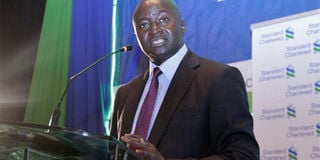Bad loans eat into StanChart share price

Standard Chartered Bank Kenya CEO Lamin Manjang during the bank's annual general meeting held at the Safari Park Hotel on May 28, 2015. Within a year, StanChart stock value has depreciated by a quarter from a 12-month high of Sh357. FILE | DIANA NGILA |
What you need to know:
- Within a year, Stanchart stock value has depreciated by a quarter from a 12-month high of Sh357. It is expected to shed value even further.
- The Sh5.5 billion that the lender owes the Central Bank is a huge liability that may weigh it down going forward, say analysts.
- Performance will also be affected by CBK’s recent tightening of the monetary policy, a decision that has led to higher lending rates.
Mounting bad loans are expected to hit Standard Chartered Bank’s fortunes on the stock market.
The bank’s profitability has declined thanks mainly to high non-performing loans (NPLs) that threaten to choke the banking industry.
Standard Investment Bank (SIB) analysts say that StanChart share price is at its lowest in more than a decade.
Within a year, the value has depreciated by a quarter from a 12-month high of Sh357, with indications that it will shed its value even further.
“While we retain our ‘Hold’ recommendation (given NPL uncertainty and poor visibility of strategy due to low management investor engagement) given StanChart’s above sector return on equity, payout, liquidity and capital assets ration, any further price deterioration would offer an attractive entry point,” the analysts said.
SALE OF PROPERTY
In the half-year ending June 2015, the lender reported a 36 per cent drop in profit after tax to Sh3.9 billion from Sh6.1 billion in a similar period in 2014. The decline was on the back of bad debts brought forward.
Last year’s profit was boosted by the Sh1.5 billion one-off earnings from sale of property in the second quarter.
“The performance in the first half was subdued largely due to the after-effects of the sharp increase in our non-performing loan book in 2014 coupled with the large net gain on sale of property which has not been repeated,” said StanChart’s chief executive officer, Mr Lamin Manjang.
“As we stepped up the recoveries of these non-performing loans, the loan book declined in the first quarter,” Mr Manjang added.
Ecobank Capital’s Head of Banking Research George Bodo is, however, optimistic, saying StanChart’s unimpressive performance is not as a result of underlying factors — such as high lending rates and bad loans — but rather due to the absence of exceptional earnings from sale of property as was the case in the second quarter of 2014.
OPERATING INCOME
“The impact can be seen on the line item ‘other income’, which plummeted 85 per cent year-on-year on account of this asset sale in 2014. Otherwise on a quarter-on-quarter basis, profit after tax rose 14 per cent and even the topline was very stable with operating income up 8 per cent quarter to quarter (driven by strong earnings from forex trading),” Mr Bodo said.
Loans remained little changed rising 0.4 per cent to Sh123.3 billion in the first half of 2015 from Sh122.7 billion in the same period in 2014. This is attributed to the bank’s cautious approach in lending in a bid to tame surge in bad loans.
As a result of subdued lending, net interest income remained unchanged at Sh8.7 billion. The lender also set aside Sh1.29 billion as provision for bad loans up from Sh857 million allocated in the half of 2014.
“While loan growth momentum slowed in 2014, following 179 per cent year-on-year spike in NPLs, we do not expect StanChart to retract fully to its old conservative asset allocation strategy,” the analysts said.
As part of a wider strategy, the lender restructured its operations last year in a bid to position itself to serve the small and medium enterprises.
EXCEPTIONAL INCOME
SIB analysts further say that the Sh5.5 billion that the lender owes to the Central Bank is a huge liability that may weigh it down going forward despite the bank having one of the highest liquidity ratios in the industry.
“This level of outstanding liabilities to CBK was last seen in 2011, when a number of banks sought funding from the CBK discount window and applied it to local and Forex money markets,” they said.
Mr Bodo says that because the bank will not be getting “exceptional income” from asset sales, full year 2015 profit before tax is projected to drop by 20 per cent compared to 2014’s.
“However, we expect funded income to grow by 10 per cent year-on-year on account of reduced balance sheet funding costs. We also expect the bank’s robust cost containment strategies to pay off. Resultantly, non-funded costs will rise by a marginal 10 per cent year on year on account of improving loan book performance (hence reduced provisions) and stable personnel costs,” he said.
Performance will also be affected by CBK’s recent tightening of the monetary policy, a move that has already led to higher lending rates in the market.




